
Moving can often be a race against time, and when it’s done in a hurry, it brings a unique set of challenges. Whether it’s due to a sudden job transfer, end of lease, or any other urgent scenario, packing tips for moving in a hurry become invaluable. The key to mastering a swift move lies in efficient packing – it’s not just about speed, but also about ensuring everything arrives at your new home safely and in an organized manner. In the following sections, we’ll explore essential strategies and tips designed to streamline your packing process. These insights are tailored to help you pack effectively, even when time is not on your side, turning a potentially chaotic experience into a manageable and successful move.
Understanding the Time Crunch
When life throws a curveball, sometimes you find yourself needing to move with little notice. Common scenarios that necessitate a rapid relocation include an unexpected job offer in a different city, sudden changes in personal circumstances, or urgent housing issues like lease expirations or sold properties. In fact, a survey indicates that around 40% of moves are due to job changes, many of which require a swift transition.
Packing under a tight schedule poses several unique challenges. Firstly, there’s the sheer volume of tasks that need to be completed in a limited time frame. Unlike a leisurely move, where you can pack gradually, a hurried move demands quick decision-making and action. This can lead to stress and the potential for oversight, such as forgetting to pack important items or failing to properly secure fragile belongings.
Another challenge is maintaining organization. When rushed, it’s easy to pack items haphazardly, leading to confusion and disarray both during the move and when unpacking at your new home. This lack of organization can significantly prolong the settling-in process, adding to the stress of the move.
Finally, there’s the physical and emotional toll. Rapidly packing up an entire household is not just physically demanding but can also be emotionally taxing. Nostalgia and the need to make quick decisions about what to keep or leave can add an extra layer of complexity to the process.
Understanding these challenges is the first step towards overcoming them. The upcoming sections will provide practical tips and strategies to help you navigate the time crunch of a hurried move, ensuring that your transition is as smooth and stress-free as possible.
Preparation: The Key to Speed

In the whirlwind of a hurried move, preparation becomes your greatest ally. The efficiency and success of your move hinge largely on how well you prepare in advance, even if that preparation time is short. Here’s how to set the stage for a quick and effective move:
- Quick Preparation is Crucial
- Understand that every minute counts. The sooner you start, the better. Quick preparation involves setting clear, achievable goals for each day leading up to the move.
- Break down the packing process into smaller tasks. This makes the overall job seem less daunting and helps maintain focus and momentum.
- Creating a Rapid Action Plan
- Draft a concise moving checklist. This should include all necessary tasks, from packing to arranging transportation, and setting up essential services at your new home.
- Assign deadlines to each task on your list. Be realistic yet ambitious with your time management.
- Prioritize tasks based on urgency. For instance, securing a moving company or rental truck should be high on the list, followed by packing non-essential items.
- Gathering Packing Supplies in Advance
- Collect all necessary packing supplies before you start. This includes boxes, tape, bubble wrap, labels, markers, and specialty containers like wardrobe boxes.
- Consider the specific needs of your belongings. For example, electronics require anti-static packing materials, while artwork may need flat, padded boxes.
- Don’t underestimate the amount of supplies you’ll need. It’s better to have extra than to run out mid-way through packing.
Efficiency Tips
- Use suitcases, duffel bags, and even laundry baskets to pack items. These can be more space-efficient than boxes and are easier to transport.
- Keep a ‘packing station’ with all your supplies in one place to avoid wasting time looking for materials.
- Label boxes as you pack them. This saves time during the unpacking process and helps movers know where to place boxes in your new home.
By focusing on rapid preparation, you can significantly reduce the stress and chaos of a last-minute move. This approach ensures that you remain in control of the process, even when time is not on your side.
Packing Essentials First
In the haste of a hurried move, it’s easy to overlook the essentials you’ll need immediately upon arrival at your new home. To avoid this, it’s crucial to pack a well-thought-out “essentials” box or suitcase. Here’s how to do it effectively:
- Identifying Essential Items
- Essentials include items you use daily and cannot do without. Think about your routine for the first few days after the move. This typically includes toiletries, a few changes of clothes, medications, chargers for electronic devices, basic kitchenware, and perhaps a coffee maker or kettle.
- Don’t forget important documents such as passports, lease or property documents, and essential contacts.
- Creating an Essentials Box or Suitcase
- Choose a suitcase, box, or bag that is distinct and easily recognizable. This ensures that it doesn’t get lost among the myriad of other boxes during the move.
- Pack as if you’re going on a short trip. Include toiletries, a couple of outfits, pajamas, essential kitchen items, and any other day-to-day necessities.
- Consider the needs of all family members, including pets. Children might need their favorite toy or book to feel comfortable, while pets will need their food, bowls, and a toy or two.
Lifehacks for Packing Essentials
- Ziploc Bags: Use Ziploc bags to organize smaller items like chargers, medications, or jewelry. They keep things together and prevent them from getting lost.
- Clear Containers: If using a box for essentials, a clear plastic container can be beneficial as it allows you to see the contents at a glance.
- Last In, First Out: Make sure the essentials box or suitcase is the last thing loaded onto the moving truck and the first thing taken out. This ensures immediate access upon arrival at your new home.
Remember, the essentials box or suitcase is meant to cover your immediate needs for the first few days post-move. It’s a temporary solution to ease your transition until you have time to unpack fully.
By prioritizing and efficiently packing an essentials box or suitcase, you ensure a smoother and more comfortable transition into your new home, even amidst the hurried circumstances of a quick move.
Room-by-Room Packing Strategy

Packing for a move can be overwhelming, but tackling it room-by-room makes the process more manageable and efficient. Here’s how to approach each room, along with some useful tricks to speed up the process:
- Start with Lesser-Used Rooms
- Begin with rooms and areas you use less frequently, like guest rooms, basements, or attics. This strategy allows you to start packing without disrupting your daily routine.
- Pack decorative items, out-of-season clothing, and rarely used kitchenware first.
- Kitchen
- The kitchen can be complex due to the number of small, fragile items. Start with items you rarely use.
- Wrap dishes and glasses individually and use plenty of cushioning. Stack plates vertically, as they’re less likely to break.
- Use pots and large bowls to hold smaller items, maximizing space.
- Living Room
- Pack books, DVDs, and other media in small boxes to prevent them from becoming too heavy.
- Cushion and wrap decorative items and electronics. Use original boxes for electronics if available.
- Roll up rugs and secure them with straps or rope.
- Bedrooms
- Leave clothes in drawers and simply secure the drawers if moving the entire dresser. For loose clothing, use wardrobe boxes.
- Pack bedding and curtains in vacuum seal bags to save space.
- Disassemble furniture if possible to save space and make moving easier.
- Bathroom
- Pack toiletries and medicines separately. Ensure caps are tight and bags are leak-proof.
- Keep a separate bag for essential toiletries that you’ll need immediately.
- Garage and Outdoor Items
- Sort through tools, garden supplies, and outdoor equipment. Dispose of anything that can’t be transported, like certain chemicals.
- Use sturdy boxes for heavy tools and label them as heavy.
- Prioritizing Rooms Based on Daily Use
- Keep essential items in your bedroom, bathroom, and kitchen unpacked until the last day.
- Pack these rooms in reverse order of how you started: start with the kitchen, then bedrooms, and finally the bathroom.
Useful Packing Tricks
- Photograph Electronics Setups: Take a picture of how your electronics are connected so you can easily reassemble them later.
- Clothing Hack: Keep clothes on hangers and simply cover them with garbage bags for easy transport.
- Box Labeling: Label boxes on the side and not the top so you can see the labels even when boxes are stacked.
This room-by-room strategy helps you stay organized and systematically tackle the packing process, making your move quicker and more efficient.
Speed Packing Techniques
When moving in a hurry, speed is of the essence. Employing specific packing techniques can drastically cut down on time and make your move more efficient. Here are some speed packing techniques that can help:
- Bundling Clothes on Hangers
- Keep clothes on their hangers and bundle them together. You can cover them with large garbage bags or wrap them in sheets for protection. This technique allows you to quickly move entire sections of your wardrobe without folding each item, and they can be easily hung up again in your new home.
- Use zip ties or rubber bands to group hangers together for easy handling.
- Using Suitcases for Heavy Items
- Suitcases are ideal for packing heavy items since they are sturdy and easy to transport thanks to their wheels. Books, shoes, and heavy kitchen items like pots and pans can be packed into suitcases.
- The extendable handles and wheels on suitcases make them a convenient tool for moving heavy items without much physical strain.
- Utilizing Vacuum Bags for Bulky Items
- Vacuum seal bags are perfect for bulky items like bedding, pillows, and off-season clothing. These bags compress the items, saving a significant amount of space in the moving truck.
- Vacuum bags also provide an added layer of protection from moisture and dirt during the move.
Other Speed Packing Tips
- Box Assembly Line: Create an assembly line for packing boxes. Line up your boxes and move items directly into them, streamlining the process.
- Fill Gaps with Soft Items: Use socks, scarves, or other soft items to fill gaps in boxes. This provides extra cushioning and makes use of every available space.
- Multipurpose Packing: Use towels and linens as wrapping materials for fragile items. This saves on bubble wrap and reduces the number of boxes.
As you pack each box, quickly label it with its contents and the room it’s destined for. This will speed up the unpacking process and help movers know where to place boxes.
By implementing these techniques, you can pack more efficiently, saving time and effort. The goal is to minimize the number of items you need to handle individually, which is key when packing in a hurry.
Labelling for Efficiency
Proper labeling is crucial for a smooth and efficient move, especially when time is limited. Clear labels help you and your movers know exactly where each box should go in your new home, saving time and effort during the unpacking process. Here are effective labeling methods and helpful tips for maximum efficiency:
- Clear and Concise Labeling
- Write labels in bold, legible letters on at least two sides of the box and the top. This ensures visibility no matter how the boxes are stacked.
- Be specific with contents and indicate which room they belong to, e.g., “Kitchen – Pots and Pans” or “Master Bedroom – Bed Linens.”
- Color Coding System
- Assign a specific color to each room (e.g., blue for the bathroom, green for the kitchen) and use colored stickers or markers for labeling. This visual system allows for quick identification.
- Provide a color key to your movers so they can easily match boxes to rooms.
- Numbering System
- Implement a numbering system where each box has a unique number. Keep a master list that details the contents and designated room for each numbered box.
- This method is particularly useful for tracking your belongings and ensuring nothing gets lost or misplaced.
Additional Labeling Tips
- Use Pre-Printed Labels: If possible, use pre-printed labels or label makers for a more uniform and professional look.
- Highlight Fragile Items: Clearly mark boxes containing fragile items with “Fragile” or “Handle with Care” labels.
- Sealing Tape Colors: Consider using different colors of sealing tape for different rooms for an additional layer of organization.
Quick Labeling Hacks
- Smartphone Assistance: Quickly note the contents of each box in your smartphone as you pack, then transfer this information to the boxes later.
- Photograph Contents: Take a quick photo of the contents of each box before sealing it. This can help if you need to find something specific before fully unpacking.
By organizing your labeling system, you can significantly reduce the time spent sorting and rearranging boxes during and after the move, making your hurried packing efforts much more effective.
Moving Day: Final Preparations
Moving day is the culmination of all your packing efforts. To ensure everything goes smoothly, here are some last-minute packing tips and advice on organizing items for the movers or personal transport:
- Last-Minute Packing Tips
- Essentials First: Make sure your essentials box or suitcase is easily accessible. This should be the last thing you pack and the first thing you unpack.
- Personal Items: Keep personal items like identification, wallets, and important documents with you at all times.
- Final Sweep: Do a final walk-through of each room to ensure nothing is left behind. Check closets, drawers, and shelves.
- Organizing Items for Movers
- Group Boxes by Room: Keep boxes grouped by room to facilitate efficient loading and unloading. This makes it easier for movers to place boxes in the correct room at your new home.
- Heavy Items First: Instruct movers to load the heaviest items first. This includes furniture, appliances, and boxes with books.
- Fragile Items: Point out boxes containing fragile items to the movers, ensuring they know to handle these with extra care.
- Organizing for Personal Transport
- Valuables and Fragiles: Transport valuable or fragile items like jewelry, family heirlooms, or breakable keepsakes in your own vehicle.
- Easy Access Items: Keep items you’ll need immediately upon arrival (like snacks, water bottles, and a basic toolkit) in a place where you can quickly access them.
- Secure Loading: Ensure that items in your vehicle are securely packed to prevent shifting or damage during transport.
- Additional Moving Day Considerations
- Safety and Accessibility: Keep pathways clear to avoid accidents. Ensure that movers have easy access to both your old and new homes.
- Emergency Kit: Have a small emergency kit handy with basic tools, first aid supplies, and snacks.
- Child and Pet Care: If possible, arrange for children and pets to be looked after elsewhere on moving day to keep them safe and reduce stress.
By following these tips, you can make your moving day as efficient and stress-free as possible. The key is to be organized and prepared, allowing you to focus on settling into your new home.
In conclusion, mastering the art of packing tips for moving in a hurry is all about being strategic, organized, and efficient. By decluttering first and focusing on essentials, you set a solid foundation for a speedy packing process. Employing room-by-room strategies ensures that no area is overlooked, while specific techniques like bundling clothes on hangers, using suitcases for heavy items, and utilizing vacuum bags for bulky goods optimize space and minimize packing time. Clear and concise labeling is a small step that makes a big difference in keeping track of your belongings and facilitating the unpacking process.
These strategies are not just about saving time; they are crucial for maintaining a sense of calm and control during what can be a hectic period. A hurried move doesn’t have to be a chaotic one. With these tips, you can ensure that your belongings are not only packed quickly but also arrive at your new home safe and sound.
Furthermore, while these tips are designed to make your move as efficient as possible, sometimes the best solution in a time crunch is to enlist professional help. Consider hiring a moving service like Affordable Moving for an even quicker and more seamless moving experience. Professional movers can provide the expertise and resources to handle your move expertly, especially when time is of the essence.
Remember, a successful move, even a hurried one, is achievable with the right approach and preparation. By following these packing tips for moving in a hurry, you’re well on your way to a stress-free transition to your new home.


